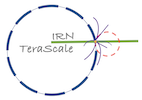Orateur
Description
Directional detection is the only admitted strategy for the unambiguous identification of galactic Dark Matter (DM) even in the presence of an irreducible background. The directional detection strategy relies on the simultaneous measurements of the energy and the direction of a DM-induced nuclear recoil, and on the correlation of the recoil direction with the expected incoming WIMPs direction. Recoil energies must be searched in the keV-range: a WIMP typically transfers at maximum an energy lower than 10 keV/nucleon. The measurement of the directions of such low-energy nuclear recoils is challenging and, until the presented work, no directional detectors had achieved it.
In this talk, we present the low-energy performance of MIMAC, a directional detector based on Micromegas, demonstrating directionality down to a few keV. At low energy, the detector must operate at high gain (above 10^4). In these conditions, the interplay in signal formation between the electronic and the ionic signals distorts the 3D track reconstruction while it improves the detector sensitivity. We develop an improved procedure to reconstruct the direction of a nuclear recoil with MIMAC by handling the track distortions at high gain. We then determine the directional performance of the detector by means of mono-energetic neutron fields at 27 keV and 8 keV in order to measure the scattering angle of neutron-proton interactions. The reconstruction of the neutron energy spectra, which depends on the scattering angle, with a better than 15° angular resolution in the keV-range, achieves the target requirements for the directional strategy of detection.
A bi-chamber module of MIMAC is currently running at the Underground Laboratory of Modane (LSM) using a 10x10 cm2 Micromegas made of low-radioactivity materials. In the meantime, the collaboration is testing a 35x35 cm2 Micromegas, aiming for an installation of such a larger detector at the LSM in 2023. This will be the elementary brick for the m3 MIMAC detector.
More details can be found at: https://arxiv.org/abs/2112.12469

